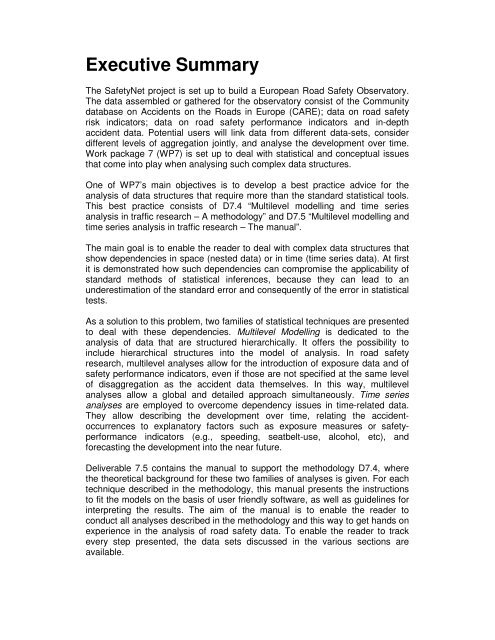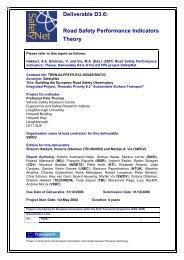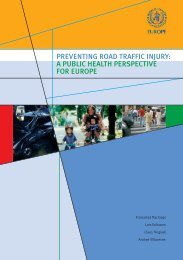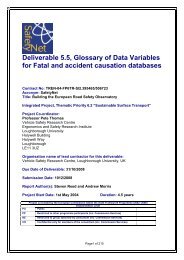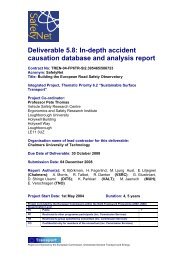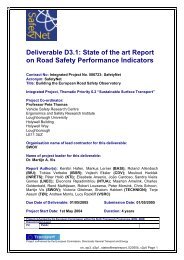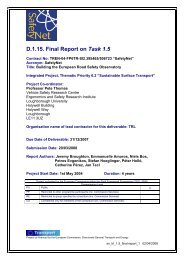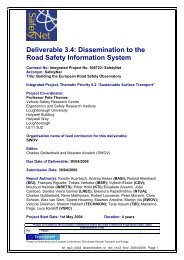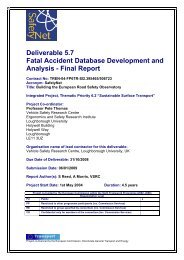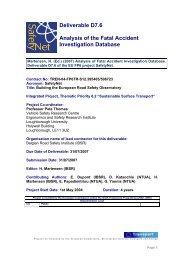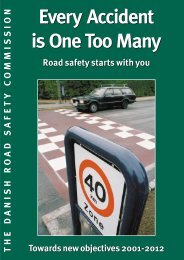Multilevel modelling and time series analysis in ... - ERSO - Swov
Multilevel modelling and time series analysis in ... - ERSO - Swov
Multilevel modelling and time series analysis in ... - ERSO - Swov
You also want an ePaper? Increase the reach of your titles
YUMPU automatically turns print PDFs into web optimized ePapers that Google loves.
Executive SummaryThe SafetyNet project is set up to build a European Road Safety Observatory.The data assembled or gathered for the observatory consist of the Communitydatabase on Accidents on the Roads <strong>in</strong> Europe (CARE); data on road safetyrisk <strong>in</strong>dicators; data on road safety performance <strong>in</strong>dicators <strong>and</strong> <strong>in</strong>-depthaccident data. Potential users will l<strong>in</strong>k data from different data-sets, considerdifferent levels of aggregation jo<strong>in</strong>tly, <strong>and</strong> analyse the development over <strong>time</strong>.Work package 7 (WP7) is set up to deal with statistical <strong>and</strong> conceptual issuesthat come <strong>in</strong>to play when analys<strong>in</strong>g such complex data structures.One of WP7’s ma<strong>in</strong> objectives is to develop a best practice advice for the<strong>analysis</strong> of data structures that require more than the st<strong>and</strong>ard statistical tools.This best practice consists of D7.4 “<strong>Multilevel</strong> <strong>modell<strong>in</strong>g</strong> <strong>and</strong> <strong>time</strong> <strong>series</strong><strong>analysis</strong> <strong>in</strong> traffic research – A methodology” <strong>and</strong> D7.5 “<strong>Multilevel</strong> <strong>modell<strong>in</strong>g</strong> <strong>and</strong><strong>time</strong> <strong>series</strong> <strong>analysis</strong> <strong>in</strong> traffic research – The manual”.The ma<strong>in</strong> goal is to enable the reader to deal with complex data structures thatshow dependencies <strong>in</strong> space (nested data) or <strong>in</strong> <strong>time</strong> (<strong>time</strong> <strong>series</strong> data). At firstit is demonstrated how such dependencies can compromise the applicability ofst<strong>and</strong>ard methods of statistical <strong>in</strong>ferences, because they can lead to anunderestimation of the st<strong>and</strong>ard error <strong>and</strong> consequently of the error <strong>in</strong> statisticaltests.As a solution to this problem, two families of statistical techniques are presentedto deal with these dependencies. <strong>Multilevel</strong> Modell<strong>in</strong>g is dedicated to the<strong>analysis</strong> of data that are structured hierarchically. It offers the possibility to<strong>in</strong>clude hierarchical structures <strong>in</strong>to the model of <strong>analysis</strong>. In road safetyresearch, multilevel analyses allow for the <strong>in</strong>troduction of exposure data <strong>and</strong> ofsafety performance <strong>in</strong>dicators, even if those are not specified at the same levelof disaggregation as the accident data themselves. In this way, multilevelanalyses allow a global <strong>and</strong> detailed approach simultaneously. Time <strong>series</strong>analyses are employed to overcome dependency issues <strong>in</strong> <strong>time</strong>-related data.They allow describ<strong>in</strong>g the development over <strong>time</strong>, relat<strong>in</strong>g the accidentoccurrencesto explanatory factors such as exposure measures or safetyperformance<strong>in</strong>dicators (e.g., speed<strong>in</strong>g, seatbelt-use, alcohol, etc), <strong>and</strong>forecast<strong>in</strong>g the development <strong>in</strong>to the near future.Deliverable 7.5 conta<strong>in</strong>s the manual to support the methodology D7.4, wherethe theoretical background for these two families of analyses is given. For eachtechnique described <strong>in</strong> the methodology, this manual presents the <strong>in</strong>structionsto fit the models on the basis of user friendly software, as well as guidel<strong>in</strong>es for<strong>in</strong>terpret<strong>in</strong>g the results. The aim of the manual is to enable the reader toconduct all analyses described <strong>in</strong> the methodology <strong>and</strong> this way to get h<strong>and</strong>s onexperience <strong>in</strong> the <strong>analysis</strong> of road safety data. To enable the reader to trackevery step presented, the data sets discussed <strong>in</strong> the various sections areavailable.


